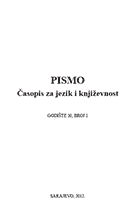Struktura narativne instance u romanu Derviš i smrt Meše Selimovića
Structure of the Narrative Instance in the Novel Derviš i smrt by Meša Selimović
Author(s): Tatjana BečanovićSubject(s): Literary Texts
Published by: Bosansko filološko društvo
Keywords: auto-communication; Saint George’ Day; prayer; tekke; classificational semantic field; anti-field; religious cod; dogma
Summary/Abstract: An extremely complicated character in the novel, Nuruddin Ahmed, has been closely associated with spatial meaning, and has been built on the principle of sharp opposition of its substructures included in a very dynamic and variable composition. Therefore the character is a constant source of increased informativeness of the text. In the first, the chapter is dominated by the process of self-identification that is activated as required in the channel I - I, in which is formed a strong relationship between the character and space. The semiotic functions of establishing order have been assigned to the narrative “I” and the spatial structure of the tekke, resulting in amalgamation of characters and spaces, and classification functions which have been combined in a single instance of the I - tekke, acting as a peculiar amalgam of the narrative and the semiotic. Therefore, the author selects the purest of the purest representatives of order and violation of the norm, so the incident bears the greater amount of grief, in order to start with the deconstruction of religion, meaning, God and Dogma. The spatial model of the world Selimović describs in the novel appears to be a strong organizational factor of the plot around which have been created the non-spatial form and meaning, primarily ethical and ideological, implying that, based on the complex language space, the units have been transformed into powerful organizational centers, creating a non-spatial meanings of polyphonic articulation. The highlighted structural position and numerous functions contribute to the fact that Saint George’ Day, mentioned in the novel Derviš i smrt, has been modeled as a temporal unit of an extraordinary semantic load. This feature is put by the author at the service of the boundaries that represent the temporal and subjective series, separating, at the same time, the semantic field and the anti-field.
Journal: Pismo - Časopis za jezik i književnost
- Issue Year: 2012
- Issue No: 10
- Page Range: 153-173
- Page Count: 21
- Language: Serbian

